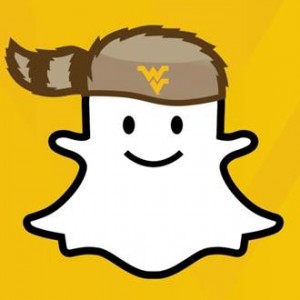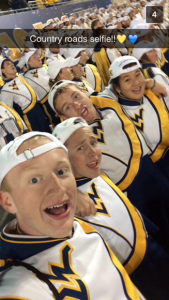As I explained in the 1st post of this series, SnapChat is really starting to look like a serious contender in the game of communication platforms with college students.
Is it time to adopt SnapChat for higher ed institutions?
As you know, we can learn a lot from the experience of early adopters of any new technology, channel or platform in higher education.
 That’s the reason for this series of interviews from early adopters of SnapChat in higher education.
That’s the reason for this series of interviews from early adopters of SnapChat in higher education.
After Nikki Sunstrum from UM, Jason Boucher from UNH and Tyler Thomas from UNL, Tony Dobies, Social Media Strategist at West Virginia University who presented about SnapChat at the Higher Ed Social Media Conference, has accepted to answer my questions about his experience with SnapChat.
1) When did you start using SnapChat at WVU and what was your goal?
 We started our Snapchat account in August 2014.
We started our Snapchat account in August 2014.
Our goal was to speak more directly and personally with our current and prospective students, as that was something we had issues with in the past and had an idea based on the information about Snapchat that this could be our answer.
2) Why did you add Snapchat to your social media toolbox?
This is our best and most engaging form of communication with students, so that’s how we use it.
We get out the crucial deadlines and other pieces of info in our Stories.
But, we also do a great job of talking back and forth with our audience in personal snaps with them. That seemingly offline back-and-forth conversation is something we just can’t accomplish on Facebook or Twitter much of the time. It’s about relationship building for us more so than any other social platform.
3) What results did you get? What was the feedback from students?
 We have about 7,000 followers, and the feedback has been amazing.
We have about 7,000 followers, and the feedback has been amazing.
Students are always surprised when we tell them we’re on Snapchat – it’s still an oddity in higher ed after all. But, the content fits the audience, and so it doesn’t make them uncomfortable.
We aren’t trying to talk in a way students can’t understand; we’re using their language and talking about topics they can relate to, so it feels very organic.
4) How do you plan to use these connections going forward?
We’re always thinking of ways to branch out.
We’ll be allowing students to take over the account for 24 hours at some point this spring. In addition, we’ve already had our president hijack our Snapchat, too.
We’ve began and will continue to speak directly to prospective students who visit or who we’d like to visit, as well.
Stay tuned
In the next post in this SnapChat series, I’ll wrap with some lessons learned from the 6 higher ed professionals using SnapChat with college students I’ve interviewed.




RT @karinejoly: [New Post] SnapChat Early Adopters in #highered: West Virginia University (@WestVirginiaU) http://t.co/zH5g5Ukh33
RT @karinejoly: [New Post] SnapChat Early Adopters in #highered: West Virginia University (@WestVirginiaU) http://t.co/zH5g5Ukh33
RT @karinejoly: [New Post] SnapChat Early Adopters in #highered: West Virginia University (@WestVirginiaU) http://t.co/zH5g5Ukh33
New post: College Web Editor – SnapChat Early Adopters in #highered: West Virginia University (@WestVirginiaU) http://t.co/zDiFihajoq
College Web Editor – SnapChat Early Adopters in #highered: West Virginia University (@WestVirginiaU): As I exp… http://t.co/iKt5N7Ki0I
RT @bloghighed: New post: College Web Editor – SnapChat Early Adopters in #highered: West Virginia University (@WestVirginiaU) http://t.co/…
Clever: “Students to take over the account for 24 hours at some point this spring.” SnapChat Early Adopters #sachat http://t.co/jQQWr6qmNc
Nice article. I’m a sorta-early adopter. RT @karinejoly: SnapChat Early Adopters in #highered: http://t.co/j2Zt1NZay7 http://t.co/yY6AGW4Pst
SnapChat Early Adopters in #highered: West Virginia University (@WestVirginiaU) http://t.co/AWGlZBh6Zf
RT @dmolsen: SnapChat Early Adopters in #highered: West Virginia University (@WestVirginiaU) http://t.co/AWGlZBh6Zf
SnapChat Early Adopters in #highered: West Virginia University (@WestVirginiaU) http://t.co/9p3SOBMRKv #hesm http://t.co/oEo3dW1N4X
SnapChat Early Adopters in #highered: West Virginia University (@WestVirginiaU) http://t.co/h7sJb1jzCu
RT @karinejoly: SnapChat Early Adopters in #highered: @WestVirginiaU http://t.co/3WvwOkgfVY #casesmc #hesm http://t.co/tqG9NiZMTv
RT @MassDHE: College Web Editor – SnapChat Early Adopters in #highered: West Virginia University (@WestVirginiaU) http://t.co/6kGL3ZSqH5
RT @MassDHE: College Web Editor – SnapChat Early Adopters in #highered: West Virginia University (@WestVirginiaU) http://t.co/6kGL3ZSqH5